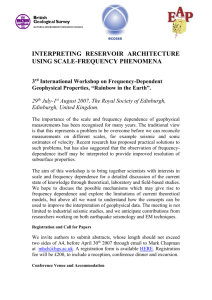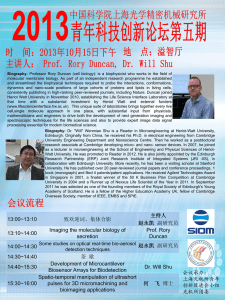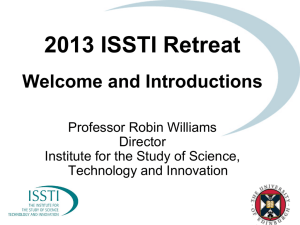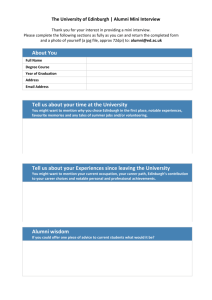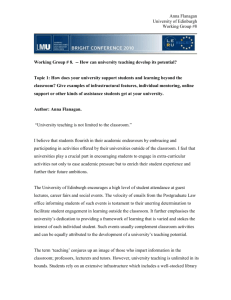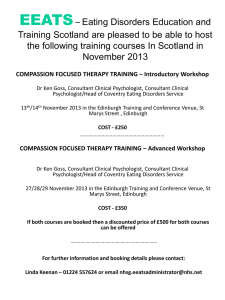Feedback Form - Adaptation Scotland
advertisement
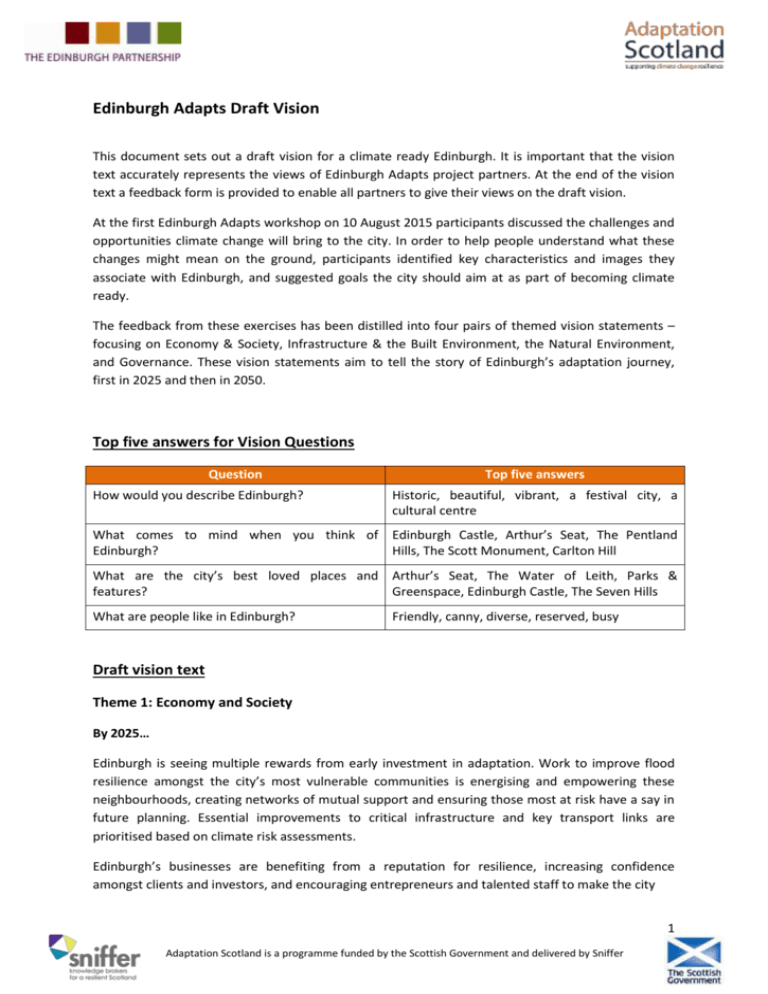
Edinburgh Adapts Draft Vision This document sets out a draft vision for a climate ready Edinburgh. It is important that the vision text accurately represents the views of Edinburgh Adapts project partners. At the end of the vision text a feedback form is provided to enable all partners to give their views on the draft vision. At the first Edinburgh Adapts workshop on 10 August 2015 participants discussed the challenges and opportunities climate change will bring to the city. In order to help people understand what these changes might mean on the ground, participants identified key characteristics and images they associate with Edinburgh, and suggested goals the city should aim at as part of becoming climate ready. The feedback from these exercises has been distilled into four pairs of themed vision statements – focusing on Economy & Society, Infrastructure & the Built Environment, the Natural Environment, and Governance. These vision statements aim to tell the story of Edinburgh’s adaptation journey, first in 2025 and then in 2050. Top five answers for Vision Questions Question How would you describe Edinburgh? Top five answers Historic, beautiful, vibrant, a festival city, a cultural centre What comes to mind when you think of Edinburgh Castle, Arthur’s Seat, The Pentland Edinburgh? Hills, The Scott Monument, Carlton Hill What are the city’s best loved places and Arthur’s Seat, The Water of Leith, Parks & features? Greenspace, Edinburgh Castle, The Seven Hills What are people like in Edinburgh? Friendly, canny, diverse, reserved, busy Draft vision text Theme 1: Economy and Society By 2025… Edinburgh is seeing multiple rewards from early investment in adaptation. Work to improve flood resilience amongst the city’s most vulnerable communities is energising and empowering these neighbourhoods, creating networks of mutual support and ensuring those most at risk have a say in future planning. Essential improvements to critical infrastructure and key transport links are prioritised based on climate risk assessments. Edinburgh’s businesses are benefiting from a reputation for resilience, increasing confidence amongst clients and investors, and encouraging entrepreneurs and talented staff to make the city 1 Adaptation Scotland is a programme funded by the Scottish Government and delivered by Sniffer their home. Flexible working and strong ICT infrastructure allow more people to work from home, reducing commuting. Key events in Edinburgh’s cultural calendar are prepared for more frequent extreme weather, safeguarding the city’s status as an international creative hub. A longer tourist season is creating new event opportunities drawing more visitors to the city. Universities and research institutes are seizing the chance to work with the city on cutting-edge adaptation projects, attracting funding and experts from across the world, and confirming Edinburgh’s place in the top-flight of innovative, adaptive cities. By 2050… Communities across Edinburgh are revitalised. Greater access to greenspace and localised food production is improving citizens’ health, helping people engage with nature and regain civic pride. The distinct character of Edinburgh’s neighbourhoods is maintained, but successful adaptation initiatives are empowering communities to build networks of mutual support, helping the city come together when faced with extreme weather events and other stress situations. Businesses, universities and research institutions are at the forefront of urban adaptation, exporting pioneering skills and technology to meet growing demand, and cementing Edinburgh’s position as a centre of excellence. Excellent public transport and ICT infrastructure safeguards economic resilience, creating confidence in business continuity and flexibility for employees. Well informed planning is enabling Edinburgh’s many festivals and celebrations to seize the opportunities afforded by changing tourism patterns and increase resilience to the most negative impacts of climate change. Theme 2: Infrastructure and the built environment By 2025… Thanks to integrated planning, active travel and public transport use continues to grow across the city, reducing pressures on transport infrastructure and improving health. New developments have an eye on the future, bringing together cutting edge ‘smart building’ technologies while incorporating beneficial natural processes through green/blue architecture. With fewer workers commuting, streets are quieter, cleaner, and more multi-functional spaces. Maintenance of Edinburgh’s iconic historic buildings is being gradually and subtly adjusted to take account of the changing climate, safeguarding the city’s heritage without altering its globally celebrated character. These improvements are exemplars of best practice and draw the attention of other historic European urban centres, themselves facing similar pressures from the changing climate. 2 Adaptation Scotland is a programme funded by the Scottish Government and delivered by Sniffer Disruption to the public and to critical infrastructure is kept to a minimum despite an increase the number of flooding events and storms. By investing in sustainable drainage systems, keeping existing channels clear and redirecting water flows to areas of natural permeability, water is able to flow through the city in a controlled manner, reducing the potential for damage and keeping insurance costs low. By 2050… Edinburgh’s seven hills are green nodes in the city skyline, connected by roof-top meadows and treelined streets. The towering grandeur of the Old Town and the elegant rise of the New Town are joined by a thread of innovative climate smart developments, while established communities are connected to the centre by active travel greenways. Community gardens, growing spaces, and permeable pathways and cycle lanes have replaced hard surfaces to improve water permeability across the city. With fewer cars, whole streets have been reclaimed for pedestrians, providing new civic areas and encouraging children to play outside, engaging with nature and improving their health. Sea levels continue to rise, bringing storms and high waves, but land use planning and improvements to coastal defences are protecting shore communities and important industrial areas. The city is flexible and resilient: Flexible from using natural process and state of the art technology to move with the grain of the weather. Resilient through using diverse energy sources – including community and small scale utilities projects – ensuring it is insulated from shocks in other areas. Theme 3: Natural Environment By 2025… Changes in climate are altering the distribution and populations of tree and plant species across the city, with some species flourishing while others become less common. Regular monitoring of much loved woodlands, parks and waterways allow the city to protect these natural havens from new pests and diseases. Work continues to connect the major greenspaces in the city. Communities are encouraged to make their gardens wildlife friendly and developers are working hard to include green spaces in new developments. Many brownfield sites and disused industrial areas are being transformed into ‘pop up’ community gardens, growing spaces and wildflower meadows. Nature flourishing across the city benefits people’s health and wellbeing. The natural environment is also acknowledged as playing a vital role in protecting people, their homes and their businesses. Parks and greenspaces provide areas for holding water during heavy rainfall events, while healthy trees supply shade during warmer weather and draw pollutants from the air, improving public health. 3 Adaptation Scotland is a programme funded by the Scottish Government and delivered by Sniffer By 2050… From atop Arthur’s Seat green threads weave through Edinburgh, a natural web connecting treelined neighbourhoods to flourishing community gardens and parks ringed with wildflowers that change with the seasons. Nature has grown vertically as well, with wall gardens and green roofs increasing biodiversity while also helping to manage water and temperature throughout the year. Re-wilding of the city’s rivers, streams and waterways is improving biodiversity while harnessing natural processes to improve drainage and water quality. The impacts of new pests brought by the changing climate are kept to a minimum by maintaining a balance of diverse species. The public are aware of potential risks, allowing swift action to protect nature from emerging threats. Food production is highly visible in the city again. Fruit trees, herbs and vegetables grow in city parks, tended and harvested by local communities. Sharing these skills, keen residents are being supported to transform private gardens into edible enclaves, increasing food security and reconnecting people with the food on their plate. The city’s vibrant, green reputation is attracting new families and new investment. Schools are taking advantage of the gardens on their doorsteps to teach children to engage with nature, bringing the classroom outside, and the increased opportunities for outdoor recreation have improved health and wellbeing across the population. Theme 4: Governance By 2025… It’s been ten years since organisations, businesses and communities came together to develop the city’s first adaptation action plan and the benefits are clear across all parts of the city. Partners have built strong relationships and remain firmly committed to working together to share knowledge and take action for an ever more resilient Edinburgh. Resources are targeted at areas most at risk, based on assessment of climate risk and consideration of a wide range of social and economic factors. This is helping to tackle inequality and deliver increased climate resilience as part wider transformation. Communities that are already feeling the impacts of climate change are empowered to help shape the future of their neighbourhoods. Internally, organisations are providing training to staff to ensure that climate resilience is included at all stages from strategic planning to on the ground delivery. By 2050… Empowered communities, responsible businesses and public sector organisations are working together in trust and partnership. They are shaping how the city develops as it faces new challenges and opportunities, and are working together to make sure that climate resilience is taken account of in city plans, policies and investment decisions. 4 Adaptation Scotland is a programme funded by the Scottish Government and delivered by Sniffer An engaged population is kept informed of risks such as heatwaves and severe weather through a flexible communications strategy, with neighbourhood networks helping emergency services to put well designed contingency plans into action. A significant bank of practical case studies on urban climate change impacts, built up over years of data gathering and research, allows Edinburgh to act as a knowledge hub for similar cities. The capital is staying ahead of the curve, with a reputation as an adaptation champion, continuing to attract talented thinkers, fresh investment and international recognition. 5 Adaptation Scotland is a programme funded by the Scottish Government and delivered by Sniffer The Edinburgh Adapts Draft Vision Text Feedback Form Vision statements are used to motivate and inspire multiple audiences by providing a clear, exciting view of the future. The Edinburgh Adapts Vision Statement will complement the specific interventions set down in the city’s Adaptation Action Plan by creating a snapshot of daily life in a well-adapted city. As a collaborative project we want to make sure the vision text captures the aspirations of all those involved in Edinburgh Adapts, balancing as far as possible participants visions of the success. To that end, we would value your feedback on the first draft of the vision text. This feedback will be incorporated into a second draft which, once approved, will be used to create promotional materials. Completed feedback forms should be emailed to James Garry james.garry@edinburgh.gov.uk or Fiona MacLeod fiona.macleod@edinburgh.gov.uk by 30 November 2015. 1) Please note below elements missing from the draft text which should be included and give a reason why. (E.g. The Infrastructure and Built Environment section should include reference to damp proofing homes because…) 2) Please note below any parts of the draft text which are particularly relevant/important and why. (E.g. Emphasising business confidence in the Economy and Society section is important because…) 3) Please note below any parts of the draft text which should be altered/repositioned/removed. (E.g. References to waterways in the Natural Environment section should specifically mention the Water of Leith because…) 4) Please note below any further suggestions you have for improvements to the draft text. [Type here…] 6 Adaptation Scotland is a programme funded by the Scottish Government and delivered by Sniffer
